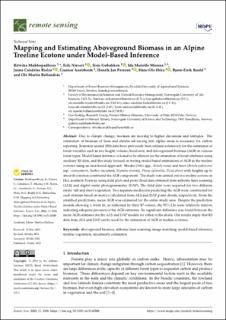| dc.description.abstract | Due to climate change, treelines are moving to higher elevations and latitudes. The estimation of biomass of trees and shrubs advancing into alpine areas is necessary for carbon reporting. Remotely sensed (RS) data have previously been utilised extensively for the estimation of forest variables such as tree height, volume, basal area, and aboveground biomass (AGB) in various forest types. Model-based inference is found to be efficient for the estimation of forest attributes using auxiliary RS data, and this study focused on testing model-based estimations of AGB in the treeline ecotone using an area-based approach. Shrubs (Salix spp., Betula nana) and trees (Betula pubescens ssp. czerepanovii, Sorbus aucuparia, Populus tremula, Pinus sylvestris, Picea abies) with heights up to about five meters constituted the AGB components. The study was carried out in a treeline ecotone in Hol, southern Norway, using field plots and point cloud data obtained from airborne laser scanning (ALS) and digital aerial photogrammetry (DAP). The field data were acquired for two different strata: tall and short vegetation. Two separate models for predicting the AGB were constructed for each stratum based on metrics calculated from ALS and DAP point clouds, respectively. From the stratified predictions, mean AGB was estimated for the entire study area. Despite the prediction models showing a weak fit, as indicated by their R2-values, the 95% CIs were relatively narrow, indicating adequate precision of the AGB estimates. No significant difference was found between the mean AGB estimates for the ALS and DAP models for either of the strata. Our results imply that RS data from ALS and DAP can be used for the estimation of AGB in treeline ecotones. | en_US |

